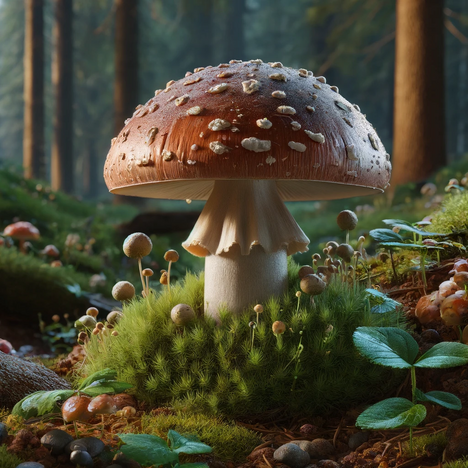Panther mushroom

What is the panther mushroom?
The panther mushroom prefers to grow in deciduous and coniferous forests and is mainly found in summer and fall. It is characterized by its dark brown to black-brown cap, which becomes flatter over time and typically has white to cream-coloured spots. These spots are remnants of the velum, a kind of veil that covers the mushroom when it is young. The stalk of the panther mushroom is also white and has a cuff, which is another remnant of the velum.
Risks and dangers of the panther mushroom for dogs
Toxic ingredients
The panther mushroom contains ibotenic acid and muscimol, two highly toxic substances that can affect the central nervous system. Even the intake of very small amounts of these substances can lead to serious symptoms of poisoning in dogs.
Symptoms of poisoning
Symptoms of panther mushroom poisoning in dogs can vary, but often include salivation, tremors, incoordination, convulsions, hallucinations and in severe cases even coma or death. These symptoms can occur within hours of ingestion and require immediate veterinary attention.
Long-term effects
Even if a dog survives poisoning by the panther mushroom, long-term neurological damage may remain. This underlines the need to prevent ingestion in the first place and to act quickly in suspected cases.
Precautionary measures and prevention
Raise awareness
Awareness of the presence and identification of panther fungus is the first step in protecting your pet. Avoid letting your dog run free in areas where such fungi are known to grow.
Early education
Train your dog not to eat from the ground and to listen to the "off" or "no" command. This can prevent accidental ingestion.
Immediate reaction
If you suspect mushroom poisoning, you should consult a vet immediately. A quick response can literally save lives.
The panther mushroom is a serious danger to dogs who spend time outdoors. While nature holds many delights and discoveries for our furry friends, it is crucial that we as responsible pet owners are aware of the dangers that certain plants and fungi can pose. Through education, prevention and quick action in an emergency, we can protect our dogs from the dangerous effects of panther fungus. Ultimately, it is our responsibility to ensure a safe environment for our faithful companions.
If you notice any signs of hypersensitivity or poisoning in your dog, you should see your vet immediately. We are not a substitute for a vet, but we try to be as accurate as possible. Every dog reacts differently and we recommend you get a second opinion or consult your vet if in doubt.
Stay healthy and take good care of your four-legged friend!😊